By Daniel G. Bausch, MD, MPH&TM, ASTMH Councilor, Tulane University Medical Center, NAMRU-6, Lima, Peru; and Hal White, MD, MPH, Sudan Interior Mission, Sebring, Florida
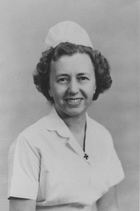 Lily Lyman Pinneo, better known as Penny, died on August 17, 2012, at age 95. In the biomedical science world, Penny is best known for being the first confirmed case of a newly discovered viral hemorrhagic illness called Lassa fever. What subsequently became known as the "Pinneo" or "LP" strain of Lassa virus was isolated from her blood after a severe hemorrhagic illness acquired in Nigeria in 1969. Penny's story was dramatically told in newspapers of the time and in the 1974 novel, Fever!, by John G. Fuller. The pain and suffering Penny experienced at the hands of this new and fearful agent might have driven persons of lesser fortitude into retirement, or at least to a career change. Not Penny. In contrast, she won her personal battle with Lassa fever, surviving after a severe and prolonged illness, and then dedicated much of her life's work to combating Lassa virus that threatened populations in West Africa.
Lily Lyman Pinneo, better known as Penny, died on August 17, 2012, at age 95. In the biomedical science world, Penny is best known for being the first confirmed case of a newly discovered viral hemorrhagic illness called Lassa fever. What subsequently became known as the "Pinneo" or "LP" strain of Lassa virus was isolated from her blood after a severe hemorrhagic illness acquired in Nigeria in 1969. Penny's story was dramatically told in newspapers of the time and in the 1974 novel, Fever!, by John G. Fuller. The pain and suffering Penny experienced at the hands of this new and fearful agent might have driven persons of lesser fortitude into retirement, or at least to a career change. Not Penny. In contrast, she won her personal battle with Lassa fever, surviving after a severe and prolonged illness, and then dedicated much of her life's work to combating Lassa virus that threatened populations in West Africa.
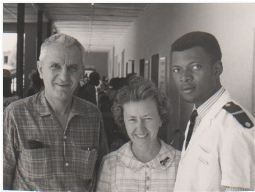
Three Lassa fever survivors: Penny with Jordi Casals and Raphael Adeyemi, a Nigeria Medical auxiliary, at the hospital in Jos, Nigeria, circa 1970.
Video: Watch "Penny's Story," in which Penny and Hal White discuss their experience with Lassa fever. Video by Lee Fritz.
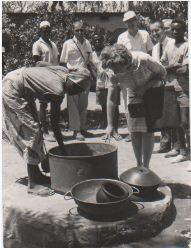 Penny was born February 21, 1917, in Newark, New Jersey, into a deeply medical and religious family. Her father was a doctor and her mother had been a missionary in India before marriage. Penny and her siblings followed suit--the two girls pursuing nursing and the boy, medicine, as was the custom at the time. Penny later added training in midwifery and anesthesiology. After obtaining her bachelor's degree from Maryville College in Tennessee in 1940 and a one-year stint at the Moody Bible Institute in Chicago, she obtained her nursing degree from the Johns Hopkins Hospital School for Nurses. Called by her deep faith and impressed by the Africa prayer band and visitors from the Sudan Interior Mission (SIM) that she met while attending Moody, Penny applied and was accepted by the SIM for overseas service, arriving in Lagos, Nigeria, on Christmas Eve 1946. After attending Hausa language school in Lagos, Penny trekked to northern Nigeria to work to open a new healthcare center, Bingham Hospital, in the city of Jos. She was initially the only staff member, making bedside tables out of orange crates. "We boiled syringes on an alcohol Sterno stove before electricity was installed," she recalled. A doctor and more nurses soon came, along with more patients.
Penny was born February 21, 1917, in Newark, New Jersey, into a deeply medical and religious family. Her father was a doctor and her mother had been a missionary in India before marriage. Penny and her siblings followed suit--the two girls pursuing nursing and the boy, medicine, as was the custom at the time. Penny later added training in midwifery and anesthesiology. After obtaining her bachelor's degree from Maryville College in Tennessee in 1940 and a one-year stint at the Moody Bible Institute in Chicago, she obtained her nursing degree from the Johns Hopkins Hospital School for Nurses. Called by her deep faith and impressed by the Africa prayer band and visitors from the Sudan Interior Mission (SIM) that she met while attending Moody, Penny applied and was accepted by the SIM for overseas service, arriving in Lagos, Nigeria, on Christmas Eve 1946. After attending Hausa language school in Lagos, Penny trekked to northern Nigeria to work to open a new healthcare center, Bingham Hospital, in the city of Jos. She was initially the only staff member, making bedside tables out of orange crates. "We boiled syringes on an alcohol Sterno stove before electricity was installed," she recalled. A doctor and more nurses soon came, along with more patients.
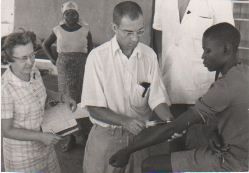 In January 1969, an American missionary nurse working in the small Nigerian village of Lassa 400 miles to the east fell sick with a fever, progressing to a heretofore unrecognized and mysterious hemorrhagic disease. She was flown by private plane to the Bingham Hospital, where she died 24 hours later. A week later, another nurse at Bingham Hospital fell sick and succumbed to the same disease. Penny was next. "I had nursed both of them, then I became ill," she recalled. Severely ill with a temperature of 107 degrees (F), Penny was first flown to Lagos and subsequently to New York, where she was admitted to Columbia-Presbyterian Hospital, where she recovered after a nine-week stay.
In January 1969, an American missionary nurse working in the small Nigerian village of Lassa 400 miles to the east fell sick with a fever, progressing to a heretofore unrecognized and mysterious hemorrhagic disease. She was flown by private plane to the Bingham Hospital, where she died 24 hours later. A week later, another nurse at Bingham Hospital fell sick and succumbed to the same disease. Penny was next. "I had nursed both of them, then I became ill," she recalled. Severely ill with a temperature of 107 degrees (F), Penny was first flown to Lagos and subsequently to New York, where she was admitted to Columbia-Presbyterian Hospital, where she recovered after a nine-week stay.
Meanwhile, a sample of Penny's blood had been sent to Yale University, where Dr. Jordi Casals was able to isolate a new virus, which he named Lassa after the site where the first patient was seen, as is the tradition with hemorrhagic fever viruses. However, the discovery came at a high cost--Dr. Casals and Juan Roman, a research technician, both became infected, the latter, fatally. Dr. Casals' survival was largely attributed to treatment of convalescent serum donated by Penny. Yale subsequently stopped all research on the samples and sent them to the Centers for Disease Control and Prevention in Atlanta, effectively beginning the era of Biosafety Level 4 precautions in the handling of virulent viruses such as Lassa, Ebola and hantavirus, and promoting CDC's predominance in this field. The story became world news.
Far from intimidated from her battle with Lassa virus, Penny emerged poised and resolved: "The peace that came in the midst of hopelessness was an experience that I am glad I didn't miss." She returned to Jos in 1970 with a small supply of her own serum intended to treat her colleague, Dr. Jeanette Troup--who had been infected with Lassa virus while performing an autopsy--unfortunately, arriving 10 days after Dr. Troup's death. Penny continued working in West Africa as a nurse, anesthetist, midwife and researcher in the fight against Lassa fever with various collaborators in Nigeria, Liberia, Sierra Leone and the United States, contributing to numerous publications on the topic. More outbreaks and cases of Lassa fever occurred and she continued to donate her blood for treatment with convalescent plasma.
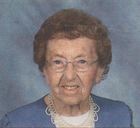 After roughly 40 years dedicated to health and missionary service in West Africa, Penny retired in 1985 and settled in Rochester, New York, with her sister, Rose, where she was involved in Sunday school, choir and pastoral care. After 10 years of Rochester cold, Penny and Rose moved to Sebring, Florida, where the SIM maintained a retirement village, becoming the chair of the mission committee, teaching bible classes and singing with the choir. Her references for her application stated: "Penny flowed with life and coped with whatever came her way and was there to do her share and more. She had very little fear."
After roughly 40 years dedicated to health and missionary service in West Africa, Penny retired in 1985 and settled in Rochester, New York, with her sister, Rose, where she was involved in Sunday school, choir and pastoral care. After 10 years of Rochester cold, Penny and Rose moved to Sebring, Florida, where the SIM maintained a retirement village, becoming the chair of the mission committee, teaching bible classes and singing with the choir. Her references for her application stated: "Penny flowed with life and coped with whatever came her way and was there to do her share and more. She had very little fear."
Spending decades in the bush in Nigeria, nobody was more on the front lines of public health, infectious disease research and service to her fellow man than Penny, with charm to boot. In Penny's words, "The Lord led me to Nigeria to work in a brand new hospital of the SIM, built for the care of our missionaries at Jos on a beautiful plateau. So I 'went out with joy and was led forth with peace.'"